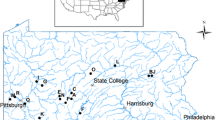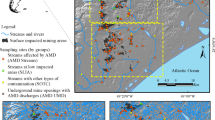Abstract
The behavior of heavy metals in acid mine drainage (AMD) is mainly controlled by pH values. Therefore, a quantitative estimation of factors affecting pH values in AMD is very important in predicting the behavior of those metals. Many different factors cause pH changes in streams affected by AMD and we quantitatively estimated those factors by making simple equations from geochemical data collected from the Dalsung mine. In a stream from that mine, the pH values decrease as the stream flows downstream from the AMD source, which is different from normal streams affected by AMD. The stream shows low pH ranges (4.04–5.96), high electrical conductivity (1,407–1,664 μS/cm), and sulfate concentration (680–854 ppm). Most ion concentrations decrease or do not show noticeable changes mainly due to dilution. The change of the iron content is most significant, even though the concentration of iron is relatively low compared with other ions. The iron concentration (13.4 ppm) becomes almost 0 ppm due to precipitation. Schwertmannite is the dominant precipitated phase downstream and whitish basaluminite is observed in the upstream. From our pH estimation, precipitation is the most important process lowering pH values from 5.96 to 4.04. The dilution factor was calculated by the concentration changes in sulfate ions. Dilution increases pH values, but compared with the precipitation factor, the contribution of the dilution factor to pH is relatively small. Alkalinity is the main factor that buffers hydrogen, which is released by precipitation. The redox changes, which were calculated from the pH and Eh values, also affect pH at each sampling site. The trend of estimated pH changes is almost identical to the observed ones, but the values are slightly different. Some errors are expected mainly due to the uncertainty in the observed Eh values and the chemistry of the added water for dilution.










Similar content being viewed by others
References
Achterberg EP, Herzl VMC, Braungardt CB, Millward GE (2003) Metal behavior in an estuary polluted by acid mine drainage: the role of particulate matter. Environ Pollut 121:283–292
Allison JD, Brown DS, Novo-Gradac KJ (1991) MINTEQA2/PRODEFA2, a geochemical assessment model for environmental systems: version 3.0 user’s manual. EPA/600/3-91/021, Environmental Research Laboratory, Office of Research and Development, U.S. Environmental Protection Agency, Athens, Georgia, USA
Bencala KE, McKnight DM, Zellweger G.W (1987) Evalution of natural tracers in an acidic and metal-rich stream. Water Resour Res 23:827–836
Bigham JM, Carlson L, Murad E (1994) Schwertmannite, a new iron oxyhydroxysulfate from Pyhsalmi, Finland, and other localities. Mineral Mag 58:641–648
Bigham JM, Schwertmann U, Pfab G (1996) Influence of pH on mineral speciation in a bioreactor simulating acid mine drainage. Appl Geochem 11:845–849
Bigham JM, Schwertmann U, Traina SJ, Winland RL, Wolf M (1996) Schwertmannite and the chemical modeling of iron in acid sulfate waters. Geochim Cosmochim Acta 60:2111–2121
Bigham JM, Nordstrom DK (2000) Iron and aluminum hydroxysulfates from acid sulfate waters. In: Alpers CN, Jambor JL, Nordstrom DK (eds) Sulfate minerals, crystallography, geochemistry, and environmental significance. Reviews in mineralogy and geochemistry, vol 40. Mineralogical Society of America, Washington, D.C., pp 351–403 (Chapter 7)
Broshears RE, Runkel RL, Kimball BA, Bencala KE, McKnight DM (1996) Reactive solute transport in an acidic stream: experimental pH increase and simulation of controls on pH, aluminum, and iron. Environ Sci Technol 30:3016–3024
Casiot C, Lebrun S, Morin G, Bruneel O, Personné JC, Elbaz-Poulichet F (2005) Sorption and redox processes controlling arsenic fate and transport in a stream impacted by acid mine drainage. Sci Total Environ 347:122–130
Cherry DS, Currie RJ, Soucek DJ, Latimer HA, Trent GC (2001) An integrative assessment of a watershed impacted by abandoned mined land discharges. Environ Pollut 111:377–388
Cornell RM, Schwertman U (1996) The iron oxides. VCH
Fortin D, Davis B, Beveridge TJ (1996) Role of Thiobacillus and sulfate-reducing bacteria in iron biocycling in oxic and acidic mine tailings. FEMS Microbiol Ecol 21:11–24
Fukushi K, Sasaki M, Sato T, Yanase N, Amano H, Ikeda H (2003) A natural attenuation of arsenic in drainage from an abandoned arsenic mine dump. Appl Geochem 18:1267–1278
Fukushi K, Sato T, Yanase N (2003) Solid-solution reaction in As (V) sorption by schwertmannite. Environ Sci Technol 37:3581–3586
Fukushi K, Sato T, Yanase N, Minato J, Yamada H (2004) Arsenate sorption on schwertmannite. Am Mineral 89:1728–1734
Jönsson J, Persson P, Sjöberg S, Lövgren L (2005) Schwertmannite precipitated from acid mine drainage: phase transformation, sulphate release and surface properties. Appl Geochem 20:179–191
Kawano M, Tomita K (2001) Geochemical modeling of bacterially induced mineralization of schwertmannite and jarosite in sulfuric acid spring water. Am Mineral 86:1156–1165
Kim JJ, Kim SJ, Tazaki K (2002) Mineralogical characterization of microbioal ferrihydrite and schwertmannite, and non-biogenic Al-sulfate precipitates from acid mine drainage in the Donghae mine area, Korea. Environ Geol 42:19–31
Konhauser KO (1998) Diversity of bacterial iron mineralization. Earth-Sci Rev 43:91–121
Langmuir D (1997) Aqueous environmental geochemistry. Prentice-Hall, Englewood Cliffs
Lee JY, Lee IH, Lee SY (1996) Geochemical study on pollution of heavy metals in soils, plants and streams in the vicinity of abandoned metal mines––Dalseong and Kyeongsan Mines. Econ Environ Geol 29:597–613 (in Korean with an English abstract)
Lee GH, Bigham JM, Faure G (2002) Removal of trace metals by coprecipitation with Fe, Al and Mn from natural eaters contaminated with acid mine drainage in the Ducktown Mining District, Tennessee. Appl Geochem 17:569–581
Little B, Wagner P, Hart K, Ray R, Lavoie D, Nealson K, Aguilar C (1998) The role of biomineralization in microbiologically influenced corrosion. Biodegradation 9:1–10
Majzlan J, Navrotsky A, Schwertmann U (2004) Thermodynamics of iron oxides: Part III. Enthalpies of formation and stability of ferrihydrite(∼Fe(OH)3), schwertmannite(∼FeO(OH)3/4(SO4)1/8), and ε-Fe2O3. Geochim Cosmochim Acta 68:1049–1059
Marsden AD, CeWreede RE, Levings CD (2003) Survivorship and growth of Fucus gardneri after transplant to an acid mine drainage-polluted area. Mar Pollut Bull 46:65–73
McKnight DM, Kimball BA, Bencala KE (1998) Iron photoreduction and oxidation in an acidic mountain stream. Science 240:637–640
McKnight DM, Kimball BA, Runkel RL (2001) pH dependence of iron photoreduction in a Rocky Mountain stream affected by acid mine drainage. Hydrol Process 15:1979–1992
Munk L, Faure G, Koski R (2006) Geochemical evolution of solutions derived from experimental weathering of sulfide-bearing rocks. Appl Geochem 21:1123–1134
Nakamura K, Yudiarto MA, Kaneko N, Kurosawa H, Amano Y (1997) A microbial method using whole cells of Thiobacillus thiooxidants for measuring sulphate in waters. Appl Microbiol Biotechnol 48:753–757
Parkhurst DL, Appelo CAJ (1999) User’s suider to PHREEQC (Version 2)––A computer program for speciation, batch-reaction, one-dimensional transport, and inverse geochemical calculations: U.S. Geological Survey water-resources investigation report 99–4259, 312
Prieto G (1998) Geochemistry of heavy metals derived from gold-bearing sulphide minerals in the Marmato District (Columbia). J Geochem Explor 64:215–222
Regenspurg S, Brand A, Peiffer S (2004) Formation and stability of schwertmannite in acidic mining lakes. Geochim Cosmochim Acta 68:1185–1197
Rose S, Elliott WC (2000) The effects of pH regulation upon the release of sulfate from ferric precipitates formed in acid mine drainage. Appl Geochem 15:27–34
Runkel RL, McKnight DM, Bencala KE, Chapra SC (1996) Reactive solute transport in streams. 2. Simulation of a pH modification experiment. Water Resour Res 32:419–430
Sánchez Espana J, López Pamo E, Santofimia E, Aduvire O, Reyes J, Barettino D (2005) Acid mine drainage in the Iberian Pyrite belt (Odiel river watershed, Huelva, SW Spain): geochemistry, mineralogy and environmental implications. Appl Geochem 20:1320–1356
Sánchez Espana J, López Pamo E, Santofimia Pastor E, Reyes Andrés J, Martín Rubí JA (2006) The impact of acid mine drainage on the water quality of the Odiel river (Huelva, Spain): evolution of precipitate mineralogy and aqueous geochemistry along the Concepción-Tintillo segment. Water Air Soil Pollut 173:121–149
Sánchez-Rodas D, Gómez-Ariza JL, Giráldez I, Velasco A, Morales E (2005) Arsenic speciation in river and estuarine waters from southwest Spain. Sci Total Environ 345:207–217
Sidenko NV, Sherriff BL (2005) The attenuation of Ni, Zn and Cu, by secondary Fe phases of different crystallinity from surface and ground water of two sulfide mine tailings in Manitoba, Canada. Appl Geochem 20:1180–1194
Soucek DJ, Cherry DS, Zipper CE (2001) Aluminum-dominated acute toxicity to the cladoceran ceriodaphnia dubia in neutral waters downstream of an acid mine drainage discharge. Can J Fish Aquat Sci 58:2396–2404
Yu JY (1998) A mass balance approach to estimate the dilution and removal of the pollutants in stream water polluted by acid mine drainage. Environ Geol 36:271–276
Yu JY, Heo B (2001) Dilution and removal of dissolved metals from acid mine drainage along Imgok Creek, Korea. Appl Geochem 16:1041–1053
Yu JY, Heo B, Choi IK, Cho JP, Chang HW (1999) Apparent solubilities of schwertmannite and ferrihydrite in natural stream waters polluted by mine drainage. Geochim Cosmochim Acta 63:3407–3416
Yu JY, Park M, Kim J (2002) Solubilities of synthetic schwertmannite and ferrihydrite. Geochem J 36:119–132
Verplanck PL, Nordstrom DK, Taylor HE, Kimball BA (2004) Rare earth element partitioning between hydrous ferric oxides and acid mine water during iron oxidation. Appl Geochem 19:1339–1354
Zis T, Ronningen V, Scrosati R (2004) Minor improvement for intertidal seaweeds and invertebrates after acid mine drainage diversion at Britannia Beach, Pacific Canada. Mar Pollut Bull 48:1040–1047
Acknowledgments
This work was supported by Korea Research Foundation Grant (KRF-2002–002-C00109).
Author information
Authors and Affiliations
Corresponding author
Rights and permissions
About this article
Cite this article
Lee, JE., Kim, Y. A quantitative estimation of the factors affecting pH changes using simple geochemical data from acid mine drainage. Environ Geol 55, 65–75 (2008). https://doi.org/10.1007/s00254-007-0965-6
Received:
Accepted:
Published:
Issue Date:
DOI: https://doi.org/10.1007/s00254-007-0965-6




